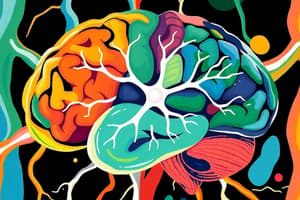Podcast
Questions and Answers
What primarily enables a bionic arm to move?
What primarily enables a bionic arm to move?
- Muscle power from the chest
- Battery power
- Remote control
- Nerve impulses from the brain (correct)
The bionic arm gives users a sense of touch by rerouting sensation nerves to the chest.
The bionic arm gives users a sense of touch by rerouting sensation nerves to the chest.
True (A)
What happens when a patient thinks about moving the bionic arm?
What happens when a patient thinks about moving the bionic arm?
The nerve impulse travels from the brain to the corresponding muscle.
Multiple sclerosis destroys the _____ sheaths of neurons.
Multiple sclerosis destroys the _____ sheaths of neurons.
Match the following diseases or conditions with their descriptions:
Match the following diseases or conditions with their descriptions:
Which part of the body is primarily modified to control the bionic arm?
Which part of the body is primarily modified to control the bionic arm?
Brain damage from physical trauma is often temporary.
Brain damage from physical trauma is often temporary.
What are common symptoms of multiple sclerosis?
What are common symptoms of multiple sclerosis?
A computer processes the _____ impulses from the nerves to make the arm perform movements.
A computer processes the _____ impulses from the nerves to make the arm perform movements.
What are electrodes attached to in the bionic arm system?
What are electrodes attached to in the bionic arm system?
What are the two main divisions of the Nervous System?
What are the two main divisions of the Nervous System?
The Peripheral Nervous System contains the brain and spinal cord.
The Peripheral Nervous System contains the brain and spinal cord.
What is the function of sensory receptors in the Nervous System?
What is the function of sensory receptors in the Nervous System?
Neurons can send information around your body by conducting __________ from one area to another.
Neurons can send information around your body by conducting __________ from one area to another.
Match the following functions with the appropriate components of the Nervous System:
Match the following functions with the appropriate components of the Nervous System:
Which type of nerves in the PNS carry information from sensory organs to the brain?
Which type of nerves in the PNS carry information from sensory organs to the brain?
The myelin sheath protects and insulates neurons, preventing the loss of electrical impulses.
The myelin sheath protects and insulates neurons, preventing the loss of electrical impulses.
How many neurons are estimated to be present in the human brain?
How many neurons are estimated to be present in the human brain?
Injured neurons in the __________ do not easily regenerate.
Injured neurons in the __________ do not easily regenerate.
What is the primary role of the Central Nervous System?
What is the primary role of the Central Nervous System?
Flashcards
Central Nervous System (CNS)
Central Nervous System (CNS)
The body's control center, consisting of the brain and spinal cord.
Peripheral Nervous System (PNS)
Peripheral Nervous System (PNS)
The network of nerves connecting the CNS to the rest of the body.
Neurons
Neurons
Specialized cells that transmit signals throughout the nervous system.
Myelin Sheath
Myelin Sheath
Signup and view all the flashcards
Sensory Receptors
Sensory Receptors
Signup and view all the flashcards
Perception
Perception
Signup and view all the flashcards
Reflexes
Reflexes
Signup and view all the flashcards
Somatic Nervous System
Somatic Nervous System
Signup and view all the flashcards
Autonomic Nervous System
Autonomic Nervous System
Signup and view all the flashcards
Nerve Regeneration
Nerve Regeneration
Signup and view all the flashcards
Bionic Arm
Bionic Arm
Signup and view all the flashcards
Nerve Rerouting
Nerve Rerouting
Signup and view all the flashcards
Electrodes
Electrodes
Signup and view all the flashcards
Computer Interface
Computer Interface
Signup and view all the flashcards
Sensory Feedback
Sensory Feedback
Signup and view all the flashcards
Multiple Sclerosis
Multiple Sclerosis
Signup and view all the flashcards
Spinal Cord Injury
Spinal Cord Injury
Signup and view all the flashcards
Paralysis
Paralysis
Signup and view all the flashcards
Viral or Bacterial Infection
Viral or Bacterial Infection
Signup and view all the flashcards
Study Notes
The Nervous System
- The nervous system is a complex organ system composed of the brain, spinal cord, and peripheral nerves.
- It is divided into two main parts: the Central Nervous System (CNS) and the Peripheral Nervous System (PNS).
- The CNS comprises the brain and spinal cord.
- The PNS consists of nerves connecting the body to the CNS. It relays information between the body and the brain.
Structural Features of the Nervous System
- The PNS is further divided into three categories: nerves that control voluntary muscles, nerves carrying sensory information from sensory organs to the brain, and nerves regulating involuntary functions (e.g., breathing, heartbeat, digestion).
Nerve Tissue
- Nerve tissue is made of specialized cells called neurons.
- The brain contains an estimated 100 billion neurons.
- Neurons are responsible for communication throughout the body by transmitting electrical signals, called nerve impulses, from one body part to another.
- Some neuron axons are covered by a myelin sheath, a fatty material that acts as insulation, preventing electrical signals from jumping to the wrong neuron.
Nerve Tissue - Continued
- Nerves are bundles of neurons surrounded by connective tissue.
- Injured neurons in the CNS typically do not regenerate.
- Neurons in the PNS, however, can sometimes regrow to repair severed connections.
Sensory Receptors
- Sensory receptors are special cells or tissues that receive inputs from the external environment and send signals to the CNS.
- Examples include light-sensitive receptors in the eyes.
- All sensory receptors throughout the body transmit information to the brain.
Communication, Coordination, & Perception
- The CNS transmits signals in both directions between the brain and the rest of the body.
- This allows the body to react to the internal and external environment.
- Perception is the function of interpreting information received from the environment.
Communication, Coordination, & Perception - Reflexes
- The spinal cord acts as a pathway for reflexes, quick actions that the brain doesn't necessarily process initially.
- Reflexes do not need the direct involvement of the brain.
Bionic Arm
- A bionic arm is controlled using nerve impulses.
- Rerouting nerves from the amputated arm to healthy muscles in the chest allows signals to control the robotic arm.
- This technology enables movement through thought.
Diseases & Disorders
- Viruses or bacteria can damage the brain permanently.
- Multiple sclerosis is a disease where the immune system malfunctions and damages the myelin sheaths of neurons.
- Physical trauma (e.g., falls) can severely damage the spinal cord, often leading to paralysis.
Studying That Suits You
Use AI to generate personalized quizzes and flashcards to suit your learning preferences.





